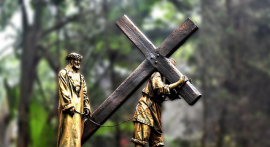
Archaeologists recently discovered Christian prayer beads from the seventh to ninth centuries on a historic island in the United Kingdom known as "Holy Island."
The Christian prayer beads were discovered around the neck of one of the earliest skeletons, which the archaeologists surmised belonged to a monk interred at the renowned early-medieval monastery, Telegraph reported. It was made from salmon vertebrae which denotes fish as an important symbol of early Christianity.
According to Dr. David Petts, the project's co-director and an expert on early Christianity at Durham University, people often thought of the grand ceremonial side of early medieval life in the monasteries and its notable work like the Lindisfarne Gospels. However, the discovery of Christian prayer beads reflected the personal devotions of early Christians.
Petts said that a zoo archaeologist Marina Chorro Giner discovered that early people modified the fish bones and turned them into something. He cited the significance of fish and the sea for the island's medieval inhabitants.
He recalled a monk named Cuthbert who arrived at Lindisfarne in the 670s and later rose to prominence as the most significant saint in medieval northern England. According to Petts, the sea has symbolic significance for Christianity in Lindisfarne because Cuthbert has narratives calming the storms as well as stories about Christ and the Apostles being fishermen and going on the Sea of Galilee.
The beads provide important insight into how ancient people lived and communicated their beliefs through items. According to the archaeologists, the salmon vertebrae they found around the neck have holes in each center which suggest that it was worn like a necklace.
The discovery comes after continuing excavations at Lindisfarne by Durham University and DigVentures, an archaeology social enterprise where volunteers and experts collaborate.
According to Lisa Westcott Wilkins of DigVentures, the discovery was remarkable since it was the first-ever sample of medieval prayer beads. She said, "We believe these beads were used as a personal object of faith, especially given that our modern word bead comes from the Old English gebed, meaning prayer."
She said that the team will further excavate the location for four years considering the size of the site. Other discoveries included coins, copper rings, and runic stones. Wilkins said that their focus right now was within the cemetery that lies next to the ruins of the 12th-century monastery.
Medieval Usage of Prayer Beads
The earlier discovery of fish vertebrae at the nearby medieval chapel in Chevington, Northumberland in 1997 has comparable alterations with the current discovery and it was dated from the 13th or 14th century which was far later than the current discovery.
According to Paternoster-Row, the discovery of medieval prayer beads suggested that it has been a common accessory for prayers among men and women. Its English name "beads" was derived from its practice "bid" which originally meant "to pray or request."
Since it was also a common practice for other religions to count their prayers during the day, they couldn't tell whether the practice had started in Christianity. According to them, the first recited prayer was "Our Father" in Latin. They said that many people who can't read during the medieval era believed that reciting "Pater Noster" 150 times was equivalent to reciting 150 Psalms. As time passed, religious people started to develop variations on this devotional practice, adding an Ave Maria (Hail Mary) or Gloria Patri after each paternoster or just reciting 150 Aves.
According to the site, from at least the 13th century onward, numerous types of "chaplets" for prayer were mentioned in the records of religious organizations. They said that it was Alanus de Rupe who established the first rosary brotherhood or guild at Douai (then a part of Flanders, now in northern France) in 1470. Most people were welcomed to join the guild even people who can't read and it has no required contributions.
Also Read: Catholic Priest Arrested Simply For Praying Against Abortion
Finding Lindisfarne's Lost History
Based on the report, archeologists were working to retrace Lindisfarne's lost history, commonly known as Holy Island, off the coast of Northumberland. According to Historic UK, the place was founded by an Irish monk named St. Aidan which is considered the holiest site of Anglo-Saxon England and the center of Christianity in Scotland.
St. Aidan proliferated Christianity in Northumberland under the reign of King Oswald. He founded the Lindisfarne Monastery around 635 and became its first Abbot and Bishop. A 7th-century Latin manuscript called Lindisfarne Gospels was also created in the place that has been displayed at the British Museum.
According to Historic UK, from the end of the eighth century, Viking raiders frequently halted on the island of Lindisfarne because of its prosperous monastery. Historians presumed the monks must be alarmed since the Vikings suddenly had not visited the monastery for 400 years.
From the 12th century until the dissolution of the Monasteries in 1537, Lindisfarne was a bustling place of worship. The monastery closed its doors at the beginning of the 18th century.
Related Article: Israel's National Library Receives One Of The Oldest Esther Scrolls In Time For Purim












